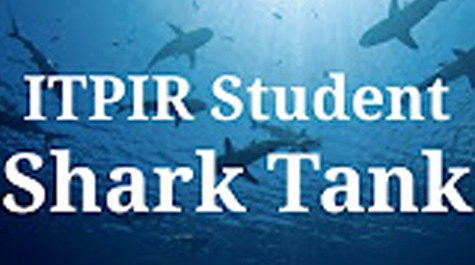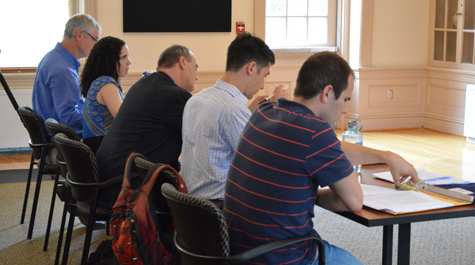ITPIR 'Shark Tank' winners announced
Fourteen teams of student researchers presented thought-provoking pitches to a faculty panel of judges on Aug. 8 during the second annual Institute for the Theory and Practice of International Relations (ITPIR) “Shark Tank” competition..
The students, all but two from William & Mary, worked on project ideas for eight weeks this summer, and provided a five-minute public preview of how their ideas would be implemented and their potential impact. Then, thanks to generous gifts from Tim Dunn ’83, Ellen Stofan ’83, and Andrew ’93 and Sarah Sugerman ’92, the panel was able to award funding totaling $20,000 to its five top choices.
{{youtube:medium|-Gxu7exnh9Q, A lighter look at Shark Tank 2016.}}
“Shark Tank provides students with a structured process to refine their own ideas, learn how to write a proposal, learn how to construct a budget and, ultimately, to write a compelling proposal and pitch it to a critical audience,” said Michael Tierney, director of ITPIR.
Tierney was part of a panel of judges that featured Stephen Hanson, vice provost for international affairs, and assistant professors Jaime Settle (government) and Dan Maliniak (government and public policy) and Brad Parks, executive director of AidData.
The five projects they selected are highlighted.
Debating Foreign Aid: A Comprehensive Text and Sentiment Analysis of the Congressional Record on International Development, by Samyuktha Mahadevan ’19, Ben Neider '18, Amanda Lewe '19.
“What we hope to find with our study is, firstly, a more comprehensive understanding of the process by which foreign aid policy is developed,” Mahadevan said. “Secondly [to find] a model of patterns regarding debates on international assistance, which can be used to understand and predict congressional action in the future.”
In doing this, Mahadevan's group will produce “a large-scale analysis and policy prediction model based on the patterns of discussion on foreign aid and an open-source online database that includes the entire Congressional Record for trends in arguments for and against foreign aid and the terminology used over time.”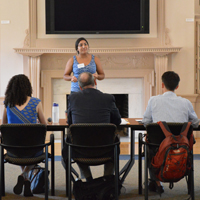
Mahadevan’s group is receiving support and guidance from Professor Maurits van der Veen, assistant professor of government and director of the STAIR lab at William & Mary.
Maliniak said he was “really excited” to see what this team of researchers would produce.
“Both in the academy and in industry, the use of prose as data is becoming increasingly frequent and sophisticated,” he said. “Sure, someone could read the entire Congressional Record for all discussion of foreign aid, and try to summarize it and search for patterns, but five different Ph.D. students could do the same task and come up with five different dissertations.
“Instead, a few W&M undergrads will be able to process more text than one could reasonably read, and look for patterns that might not be obvious otherwise.”
Modeling Internally Displaced Person Movements: A Case Study of Conflict, Infrastructure, and Urban Travel Time Analysis, by Sarah Harmon ’19 and Ethan Harrison (Rappahannock CC).
“Where do displaced groups relocate following conflict events?” Harmon and Harrison asked the judges.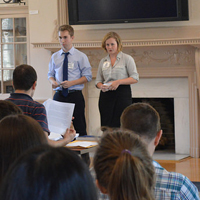
They speculated that displaced groups seek shelter in areas with the most developed infrastructure, but other factors, such as cultural similarity or security, might also shape these movements. If they can establish the push and pull factors that drive the movements of displaced people, donors might be able to predict how similar groups will behave at the onset of displacement during future crises, leading to a development and finance policy that would respond more effectively to overwhelming groups of moving people.
-
Verifying and Strengthening the TUFF Methodology, by Graeme Cranston-Cuebas ’18.
“The TUFF (tracking underreported financial flows) methodology recently completed worldwide coverage of all Chinese development finance,” Cranston-Cuebas said. “However, the methodology has been sharply criticized by some scholars due to its reliance upon open-source media collection.”
Cranston-Cuebas told judges his project will take a data-driven approach to validating the accuracy of, streamlining and improving TUFF methodology. The first phase will determine the accuracy of the TUFF methodology in tracking development finance at the project level through open-source data collection. The second phase will identify ways to streamline the methodology to improve accuracy and efficiency. The third phase will combine the results of the two and produce a white paper addendum to the current TUFF methodology."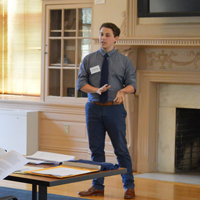
“While the TUFF methodology has produced the most comprehensive and widely used project-level dataset of Chinese foreign aid that has been cited over 100 times in academic journal articles and now three times in The Economist magazine, we have not yet proven that the TUFF method accurately classifies data by comparing the TUFF data to official records from government agencies," Tierney said. "Graeme’s research seems like an important and obvious check on the reliability of these data.”
Tracking International Development Projects and Finance: Open Data on the Activities of Commercial Volunteer-Sending Agencies, by Grace Anderson (James Madison University) and Allison Bowers ’18.
The popularity of volunteer tourism – or voluntourism – has seen exponential growth in the past 20 years. Despite this, little has been done to track and map where exactly these voluntourism projects are and what sectors are involved. Their project aims to map and sort by sector a database of voluntourism projects occurring in Cambodia and produce a final paper on various trends that emerge from the data.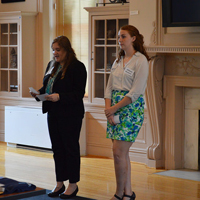
“We have spoken with several organizations, such as Save the Children and ReThink Orphanages, who have expressed strong interest and need for this database on these projects in Cambodia,” Bowers said.
Democratizing Data: A Data Gathering Tool with Infinite Expansions, by Nadia Aly ’17, Ivan Echevarria ’18 and Dan Jelf ’18.
The team proposes an online Decision Support Tool (DST) – preliminarily named GUAC – that will democratize access to internal tools created by AidData/ITPIR to reduce the time and cost of collecting, processing and publishing data.
“GUAC is the next logical step for AidData,” they told the judges. “We have been making high-quality, open data sets for years, and we have taken the same approach with our methodologies. GUAC expands on this by making it easy for anyone to create similarly high-quality data sets. AidData’s core is open data – and we want to push forward to become a leader in open data creation.”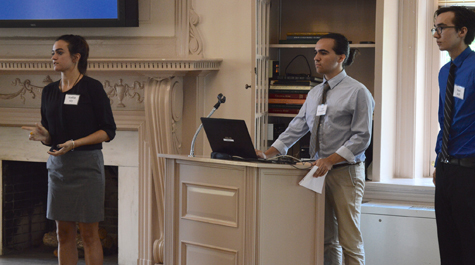
What of the projects that didn’t receive funding? Tierney pointed to a project from last year that was not funded, but the students pressed on with their work and it is now in the running for funding from the United Nations Centre for Counterterrorism.
Tierney said many ITPIR projects, such as TRIP and AidData, were created and grew from the innovative ideas of undergraduate students.
“However,” he added, “as projects get larger and become more hierarchical, the ability of 19-year-old students to weigh in on the operational decisions and strategic direction of a project has a tendency to decline. Shark Tank is an effort to institutionalize student innovation and to ensure that we don’t miss the next great idea that could lead to knowledge breakthroughs, inform policy decisions or save lives.”
Maliniak said that what impressed him most about this year’s crop of projects was the diversity of questions combined with the innovation used to try to answer them.
“It was a real reminder of how important it is to have people take a look at a familiar problem with fresh eyes,” he said. “And, as a William & Mary professor, I was reminded that I get a new crop of very smart people starting at the task every August.”















